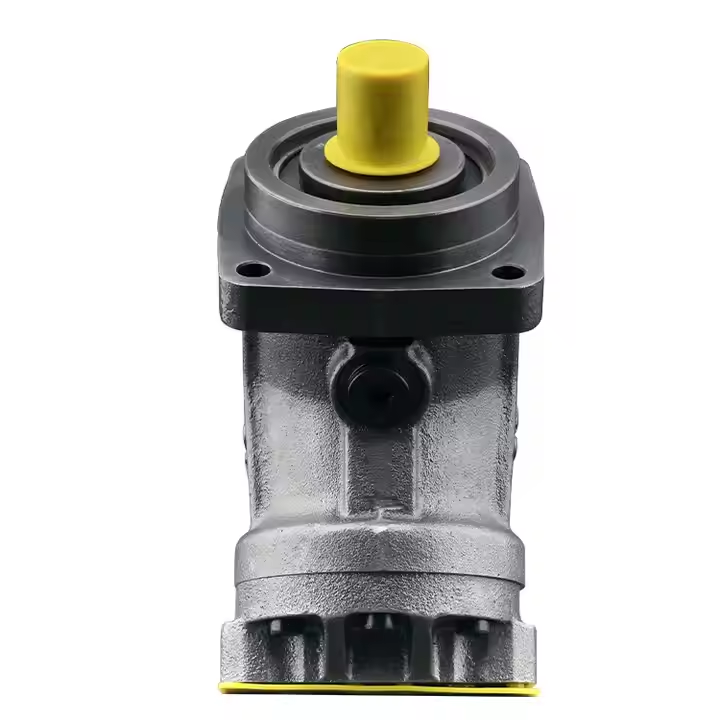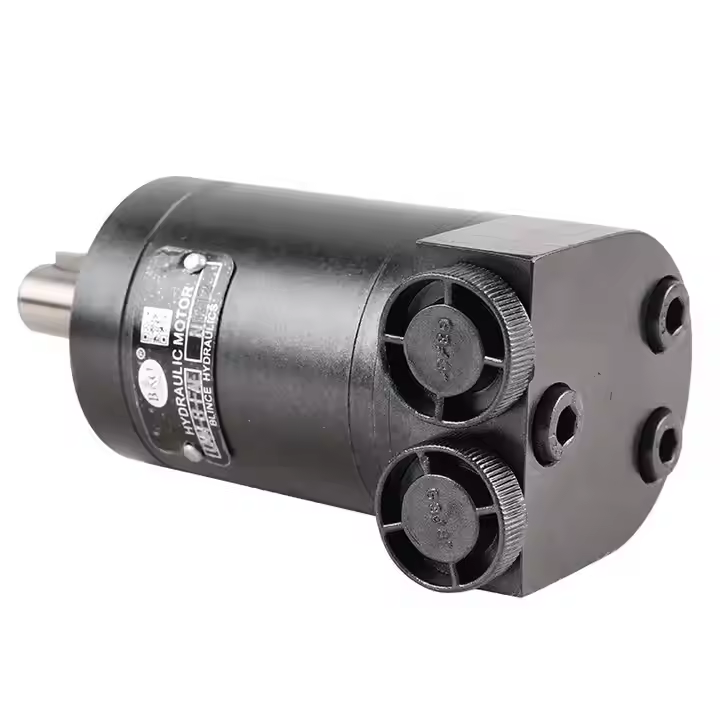When it comes to hydraulic systems, selecting the right hydraulic motor for your application is crucial. The three most common types of hydraulic motors are gear motors, piston motors, and orbital (cycloidal) motors, each with unique designs and performance characteristics. Understanding the differences in their operating environments and ideal applications can help you choose the optimal solution for your equipment. This article provides a detailed comparison of gear, piston, and cycloidal motors in various usage conditions to guide you in selecting the ideal hydraulic motor for your needs.
A typical hydraulic gear motor (example from the Blince CMF Series) features a simple external gear mechanism in a compact housing. Gear motors are known for their simple structure and small footprint, making them widely used in medium and low-pressure hydraulic systems. They typically operate within a pressure range of about 5–25 MPa, delivering stable power output in moderately demanding environments.Because of their low manufacturing cost and easy maintenance, gear motors are often the preferred choice for cost-sensitive equipment in agriculture and light-duty construction.

Common Applications:
Agricultural machinery – equipment such as mowers and harvesters that require reliable, steady hydraulic power under moderate loads.
Construction machines – light to medium-duty construction equipment (e.g. small loaders or lifts) operating under mid-range pressure conditions.
Advantages:
Simplicity & Cost-Effectiveness: Simple design with fewer parts, resulting in lower cost and easier maintenance.
Reliability in Dirty Environments: Tolerant of contaminants in hydraulic fluid, which makes them durable in less controlled conditions.
Disadvantages:
Limited Pressure Capability: Not suitable for very high-pressure systems; performance is constrained above medium pressure (~25 MPa).
Lower Precision: Generally lower efficiency and precision of control compared to piston or orbital motors.
2. Piston Motor: Best for High-Pressure and Heavy-Duty Operations
A heavy-duty axial piston motor (such as Blince’s A4V series) built for high-pressure operation in construction machinery. Piston motors are designed for high-pressure, high-power applications, often operating at pressures above 35 MPa and up to 40 MPa or more. Their design uses hydraulic pressure acting on multiple pistons that directly drive a rotor, resulting in very high torque output and efficiency. Piston motors excel in heavy-duty machinery and extreme conditions where consistent performance under load is essential. However, this robust capability comes with higher noise and vibration levels, meaning additional noise-dampening measures are often needed in the system design.

Common Applications:
Construction & mining equipment – excavators, road rollers, cranes, and mining machines that demand high power, high torque, and can involve shock loads. Piston motors provide the muscle required for these heavy machines.
Industrial presses and drilling rigs – machinery that operates under extreme pressure conditions or continuous heavy loads, where piston motors ensure stable output and durability.
Advantages:
High-Pressure Performance: Capable of handling very high pressures (35 MPa and above) for maximum power output and torque.
Precision & Efficiency: Often greater volumetric efficiency and more precise control of speed/position under load, suitable for demanding and sensitive operations.
Disadvantages:
Higher Noise/Vibration: The powerful piston mechanism can generate more noise and vibration, requiring robust mounting and noise isolation solutions.
Cost & Complexity: More complex structure and higher manufacturing cost; maintenance can be more involved compared to simpler motor types.
3. Orbital (Cycloidal) Motor: Designed for Tight Spaces and High-Precision Tasks
A compact orbital motor (cycloidal motor) from the Blince OMR Series, ideal for low-speed, high-torque outputs in space-limited installations. Orbital motors, also known as cycloidal motors, are compact and efficient units well-suited for medium to high-pressure systems (typically up to ~30 MPa). They use an internal gerotor/cycloidal gear set that enables smooth operation and precise control, making them excellent for applications requiring rapid starts and stops and frequent speed adjustments. Thanks to their high torque at low speeds and steady performance, orbital motors are often the top choice in industrial automation scenarios, especially where space is limited and precise motion is needed.

Common Applications:
Industrial automation & robotics – robotic arms, industrial robots, and automated machinery where compact motors must fit into tight spaces and provide fine control and quick response.
Machine tools and conveyors – equipment like CNC machines, rotary indexing tables, or conveyor systems that benefit from the orbital motor’s smooth low-speed rotation and frequent start/stop capability.
Advantages:
Compact Design: Small form factor allows installation in space-constrained equipment without sacrificing power or torque.
Smooth & Precise Operation: Provides high starting torque and uniform rotation with low speed ripple, enabling accurate control for high-precision tasks.
Dynamic Response: Excels at handling rapid start-stop cycles and frequent speed changes with minimal performance lag.
Disadvantages:
Not for Extreme Loads: Not intended for the absolute highest-pressure or ultra heavy-load situations that piston motors handle; orbital motors have upper limits on pressure and torque.
Specialized Use: Most effective in specific applications – they shine in niche or specialized environments, but may be less efficient in general-purpose high-speed use.
Conclusion: Choosing the Right Hydraulic Motor for Your Environment
Each motor type has distinct strengths tailored to particular operating conditions. In summary, the core differences among gear motors, piston motors, and orbital (cycloidal) motors can be distinguished as follows:
Gear Motor: Best for low-to-medium pressure applications where simplicity and cost-efficiency are priorities (e.g. agricultural machines, light construction equipment). Ideal for moderate workloads and environments up to ~25 MPa.
Piston Motor: Built for high-pressure, heavy-duty use (35 MPa and above) in equipment like large construction, mining, or industrial machines. Delivers powerful torque and high efficiency, but comes with higher cost and complexity.
Orbital (Cycloidal) Motor: Perfect for tight-space installations and systems requiring quick, precise, and frequent movements—commonly found in automated manufacturing and robotics. Provides smooth low-speed, high-torque output up to roughly 30 MPa, but is not designed for extreme high loads.
By carefully matching the motor type to your operating environment and performance requirements, you can enhance system efficiency, reduce maintenance needs, and extend the service life of your hydraulic machinery. In practice, this means considering the pressure range, load intensity, space constraints, and control precision your application demands, and then selecting the motor technology that excels under those conditions.
Need Help? Choosing the right hydraulic motor can significantly improve your system’s performance and reliability. Blince Hydraulic has decades of expertise in hydraulic drive solutions and offers a full range of gear, piston, and orbital motors to meet any application. Feel free to reach out for personalized advice.
Call to Action: To learn more about Blince Hydraulic’s hydraulic motors or to request a quote for your project, contact us or visit our website at www.blince.com. Our engineering team is ready to assist you in finding the perfect fit for your equipment.
FAQ
How are hydraulic motors used in U.S. construction equipment?
Hydraulic motors (including gear, piston, and orbital types) are integral to American construction machinery. They provide the muscle for functions like swinging an excavator’s boom, driving a loader’s lifting arms, or powering a crane’s winches and swing mechanism. This allows equipment such as excavators, loaders, and cranes to handle heavy loads with precise control, which is essential on U.S. construction sites. From drilling rigs to concrete mixer trucks, virtually all heavy construction equipment in the United States relies on hydraulic motors for reliable, high-torque movement of parts and attachments
What are the best orbital motors for industrial automation in North America?
Cycloidal or orbital motors are considered among the best options for many industrial automation tasks in North America due to their ability to deliver high torque from a compact package. These low-speed, high-torque motors are widely used in factory automation – for example, driving conveyor systems, rotary indexes, and mixers – where electric motors might be too bulky or costly. Orbital motors are valued for their versatility and reliability across industries (agriculture, manufacturing, material handling, etc.), often earning the nickname “workhorse” for their cost-effectiveness and durable performance. Leading suppliers like Blince Hydraulic offer a range of orbital motors built to North American industrial standards, ensuring efficient performance for automated machinery. (For more details or technical support, visit www.blince.com.)
How do I choose between a gear motor, piston motor, and orbital motor for my machinery in the U.S.?
Selecting the right hydraulic motor for your U.S.-based equipment depends on your application’s speed, torque, and pressure requirements. Consider the following guidelines when choosing between gear, piston, and orbital motors:
Orbital (cycloidal) motors – Best for medium-pressure systems that require steady low-speed, high-torque output and wide speed range flexibility. They excel in applications needing reliable torque at variable speeds (e.g. agricultural implements or conveyors).
Gear motors – Best for cost-sensitive, high-speed lower-torque needs. These have a simple, robust design and tolerate “dirty” oil well, making them ideal for rugged equipment where lower efficiency is acceptable (e.g. fans, pumps, or mobile attachments).
Piston motors – Best for high-pressure, high-power applications where maximum efficiency is critical. They offer superior performance (often 90%+ efficiency) and handle heavy loads (such as drive systems in large construction or mining machines) but require very clean hydraulic fluid for long life.
These recommendations align with industry practice. In summary, use a gear motor for simpler, high-speed tasks, an orbital motor for general-purpose low-speed/high-torque tasks, and a piston motor for demanding heavy-duty tasks. Always match the motor specifications to your machine’s requirements (speed, pressure, torque) and consider maintenance factors—piston units need cleaner oil, whereas gear and orbital motors are more forgiving of oil condition. If in doubt, consult a hydraulic expert or manufacturers like Blince Hydraulic for guidance on the best motor choice for your specific machinery.
What maintenance do hydraulic motors need for heavy equipment?
Proper maintenance is crucial for hydraulic motors to ensure long life and safe operation in heavy equipment. Key maintenance practices include:
Regular fluid checks: Maintain the correct hydraulic fluid level and use clean, good-quality oil. Contaminated or low fluid can cause excessive wear or overheating, so check fluid condition and top up or replace it as needed.
Filter replacements: Change hydraulic filters on schedule to keep the oil clean. Clean oil is especially important for piston motors, as poor oil quality can drastically shorten their service life.
Inspections for leaks or damage: Frequently inspect motors and hoses for any fluid leaks, damaged seals, or loose fittings. Catching leaks early prevents dirt ingress and further component damage.
Monitor temperature and noise: Ensure the motor isn’t running abnormally hot and listen for unusual noises or vibrations during operation. These can be early indicators of issues, and addressing them promptly can prevent major breakdowns.
In addition to these steps, always operate the motor within its rated capacity – avoid overloading or shock loads – and follow the manufacturer’s guidelines for lubrication and service intervals. By using the motor correctly and giving it periodic attention, you can achieve thousands of hours of reliable service from a hydraulic motor in heavy-duty U.S. equipment. Routine maintenance not only maximizes performance but also prevents costly downtime in construction and industrial operations.
Where can I source high-quality hydraulic motors in the U.S.?
In the United States, high-quality hydraulic motors can be obtained through authorized distributors, industrial suppliers, or directly from reputable manufacturers. It’s wise to choose a supplier that provides certified, high-quality products and strong after-sales support. Many top brands (both domestic and international) have distribution networks in the U.S., ensuring their motors meet SAE/ISO standards and are suitable for local industry needs. For example, Blince Hydraulic offers a complete range of gear, piston, and orbital motors for everything from heavy construction machinery to industrial automation equipment. Blince serves customers worldwide – including North America – and provides technical support to U.S. clients (you can visit www.blince.com for inquiries or assistance). Always make sure to source from a trusted vendor that can guarantee quality and provide guidance on motor selection, installation, and maintenance. This will help ensure you get a reliable hydraulic motor that keeps your equipment running efficiently in the long run


























